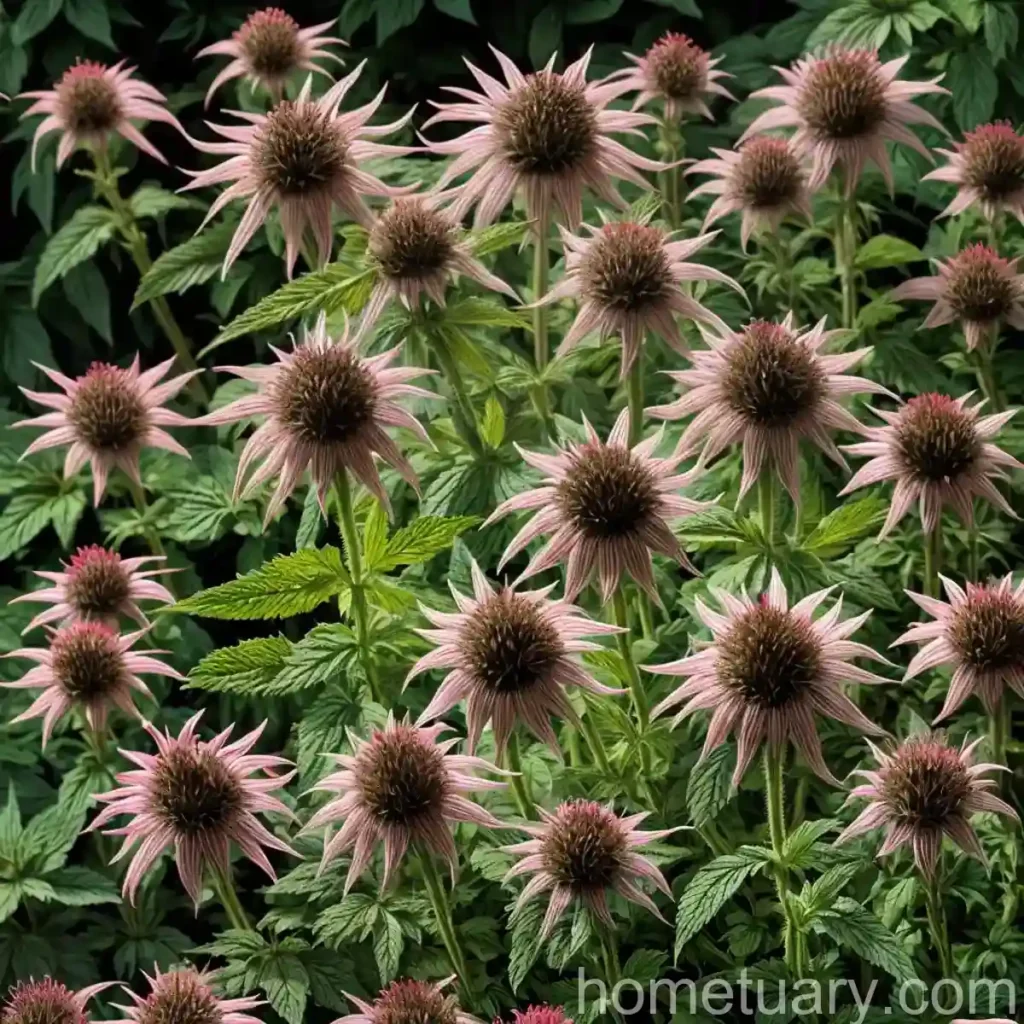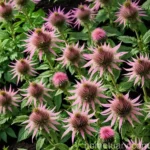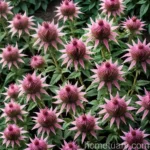Plant Spotlight: Bee Balm (Monarda didyma ‘T & M Superb Mixed’)
Welcome to another plant spotlight! Today, we’re delving into the vibrant world of bee balm, focusing on the stunning variety known as Monarda didyma ‘T & M Superb Mixed.’ This perennial plant is beloved by both gardeners and pollinators for its colorful blooms and array of potential uses.
So, grab a cup of your favorite herbal tea, sit back, and let’s explore the captivating world of bee balm together.
What is Plant: Bee Balm (Monarda didyma ‘T & M Superb Mixed’)?
Bee balm (Monarda didyma), also known as Oswego tea, horsemint, and bergamot, is a herbaceous perennial plant native to North America. It belongs to the Lamiaceae family, which also includes other well-known aromatic plants such as mint, basil, and lavender.
The ‘T & M Superb Mixed’ variety of bee balm is a particularly attractive cultivar, revered for its striking and diverse flower colors. This plant’s nectar-rich blossoms are a magnet for pollinators, making it a valuable addition to both ornamental gardens and pollinator-friendly landscapes.
Let’s journey through the various aspects of this enchanting plant, from its cultural significance to its practical uses and growing requirements.
Key Takeaways – Bee Balm (Monarda didyma ‘T & M Superb Mixed’)
Before we delve into the details, here’s a quick overview of the key takeaways about bee balm (Monarda didyma ‘T & M Superb Mixed’):
- Plant Name: Bee Balm (Monarda didyma ‘T & M Superb Mixed’)
- Family: Lamiaceae
- Native to: North America
- Common Names: Oswego tea, horsemint, bergamot
- Special Feature: Nectar-rich blossoms make it a favorite of pollinators
- Cultivar: ‘T & M Superb Mixed’ – renowned for its diverse flower colors
- Uses: Ornamental gardening, attracting pollinators, herbal remedies
- Growing Requirements: Adequate water, sunlight, well-draining soil, occasional fertilization
- Maintenance: Pruning, disease and pest management
- Propagation: Seeds, division
- Popularity: Widely embraced by gardeners for its beauty and ecological value
Now, let’s venture deeper into the fascinating world of bee balm, exploring its culture, uses, growing conditions, and much more.
Culture
Uses
Bee balm (Monarda didyma ‘T & M Superb Mixed’) is cherished for its versatility, offering a myriad of uses that appeal to both humans and wildlife:
-
Ornamental Gardening: The vibrant, tubular flowers of bee balm make it a striking addition to garden borders, wildflower plots, and cottage-style gardens. Its rich hues and attractive form add a pop of color and an ornamental flair to any landscape.
-
Attracting Pollinators: The nectar and pollen-rich flowers of bee balm act as a magnet for bees, butterflies, and hummingbirds, making it a valuable asset for pollinator gardens and wildlife-friendly landscapes.
-
Herbal Remedies: Traditionally, bee balm has been used for its medicinal properties. The leaves can be brewed into a fragrant and flavorful herbal tea, often known as “Oswego tea,” which is believed to offer various health benefits.
Water
Bee balm thrives in moist, well-drained soils and prefers consistent moisture, especially during dry spells. Adequate watering is crucial, particularly during the plant’s active growth and flowering periods. However, it’s important to avoid overwatering, as excessive moisture can lead to root rot and other fungal issues.
Sunlight
When it comes to sunlight, bee balm appreciates full to partial sun exposure. While it can tolerate partial shade, providing it with at least six hours of direct sunlight each day will result in more prolific blooming and overall healthier growth.
Fertilizer
Proper fertilization can help bee balm maintain its vigor and enhance blooming. A balanced, all-purpose fertilizer applied in early spring, as new growth emerges, can provide the necessary nutrients for healthy development and abundant flowering. Be sure to follow the manufacturer’s instructions for application rates and methods.
Soil
Bee balm thrives in well-draining soil with a slightly acidic to neutral pH (6.0-7.0). Loamy, rich, and fertile soils are ideal, but the plant is relatively adaptable and can tolerate a range of soil types, as long as they don’t become waterlogged. Amending the soil with organic matter, such as compost, can improve its structure and fertility.
Pruning
Pruning bee balm is essential for maintaining plant health, controlling its growth, and prolonging flowering. Deadheading spent blooms and removing faded foliage can encourage the plant to produce new flowers and maintain a tidy appearance. Additionally, cutting back the stems after the initial blooming phase can promote a second flush of flowers and prevent the plant from becoming leggy.
Propagation
Bee balm can be propagated by seeds or division. Collecting seeds from mature flower heads or dividing established clumps in early spring are effective propagation methods for multiplying your plant stock or sharing bee balm with fellow gardening enthusiasts.
Container Popularity
While bee balm is commonly grown in garden beds and borders, it can also thrive in containers, making it a popular choice for container gardening. Growing bee balm in containers offers the flexibility to provide optimal growing conditions, control its spread, and showcase its vibrant blooms on patios, balconies, and other confined spaces.
Now that we’ve explored the cultural aspects and practical uses of bee balm, let’s delve into its management, from disease and pest control to expert tips and fascinating trivia.
Common Diseases
Bee balm is susceptible to certain diseases that can impact its overall health and appearance. Being aware of these potential issues and taking proactive measures can help maintain a thriving and resilient plant. Some common diseases affecting bee balm include:
-
Powdery Mildew: A fungal disease that manifests as a powdery white coating on the leaves. It can weaken the plant and diminish its aesthetic appeal. To prevent powdery mildew, ensure good air circulation around the plant and avoid overhead watering.
-
Leaf Spot: This fungal disease appears as dark, water-soaked spots on the leaves, leading to yellowing and leaf drop. Removing and disposing of affected foliage, promoting adequate air circulation, and avoiding overhead watering can help prevent and manage leaf spot.
-
Botrytis Blight: Also known as gray mold, this fungal disease thrives in damp conditions. It causes grayish-brown lesions on the stems and leaves and can lead to stem collapse. Proper sanitation, avoiding overhead watering, and providing good air circulation can aid in preventing botrytis blight.
Disease Diagnosis
Identifying and diagnosing plant diseases is crucial for implementing effective disease management strategies. Key symptoms to watch for when diagnosing common bee balm diseases include:
- Fuzzy, white growth on foliage: Indicative of powdery mildew
- Dark, water-soaked spots on leaves: Suggestive of leaf spot
- Grayish-brown lesions on stems and leaves: Characteristic of botrytis blight
If you notice any of these symptoms or suspect that your bee balm is experiencing health issues, it’s essential to promptly address the situation to prevent the spread of the disease and protect the plant’s vitality.
Common Pests
While bee balm is generally resistant to most pests, it can occasionally face challenges from insect invaders. Being vigilant and taking prompt action against pest infestations is essential for preserving the health and beauty of the plant. Some common pests that may affect bee balm include:
-
Spider Mites: These tiny arachnids can cause stippling and webbing on the foliage, leading to weakened plants. Regularly inspecting the undersides of leaves and using water sprays or insecticidal soaps can help control spider mite populations.
-
Aphids: These small, soft-bodied insects can congregate on new growth and flower buds, sucking sap from the plant. Rinsing the plant with a strong stream of water or applying insecticidal soap can effectively manage aphid infestations.
-
Japanese Beetles: These voracious pests can skeletonize the leaves of bee balm and cause significant damage. Handpicking beetles from the plant and using barriers or traps can aid in controlling Japanese beetle populations.
Botanist’s Tips
Here are some expert tips to help you successfully cultivate and care for bee balm (Monarda didyma ‘T & M Superb Mixed’):
-
Good Air Circulation: Providing ample air circulation around the plant can help deter foliar diseases such as powdery mildew and botrytis blight. Proper spacing, avoiding overcrowding, and strategic garden design can contribute to better airflow.
-
Mulching: Applying a layer of organic mulch, such as shredded bark or compost, around the base of the plant can help conserve soil moisture, suppress weed growth, and insulate the roots during temperature fluctuations.
-
Companion Planting: Bee balm complements many other garden plants and is particularly attractive when paired with species such as coneflowers (Echinacea), black-eyed susans (Rudbeckia), and ornamental grasses. Incorporating complementary plants can enhance visual appeal and support beneficial ecological interactions.
-
Wildlife-Friendly Landscaping: Integrate bee balm into wildlife-friendly landscapes to attract and sustain vital pollinators, contributing to ecosystem health and biodiversity.
Fun Facts
Before we conclude our exploration of bee balm (Monarda didyma ‘T & M Superb Mixed’), here are some intriguing and fun facts about this captivating plant:
-
The genus Monarda is named after the Spanish botanist Nicolás Monardes, who wrote extensively about medicinal plants during the 16th century.
-
Many Native American tribes used bee balm for various purposes, including medicinal applications and culinary uses.
-
Bee balm flowers not only attract bees but are also appreciated by hummingbirds, which are drawn to the nectar-rich blooms.
-
The aromatic foliage of bee balm releases a delightful, citrusy scent when gently brushed or crushed, adding sensory appeal to the garden.
-
Certain bee balm varieties have been bred for improved disease resistance, extended flowering periods, and a broader color range, showcasing ongoing efforts to enhance the plant’s ornamental qualities.
Links to External Resources
For further information on bee balm (Monarda didyma ‘T & M Superb Mixed’) and related topics, the following external resources offer valuable insights and practical guidance:
- Monarda Didyma – Missouri Botanical Garden
- Bee Balm Plants: Tips for Bee Balm Care – The Old Farmer’s Almanac
- Gardening 101: Bee Balm – Gardenista
- Bee Balm: Growing and Care of Monarda Didyma – The Spruce
- Planting and Growing Monarda (Bee Balm) – HGTV
- The Bee Balm Plant: How To Grow Bee Balm In Your Garden – American Meadows
In conclusion, bee balm (Monarda didyma ‘T & M Superb Mixed’) captivates with its dazzling blossoms, ecological importance, and diverse applications. Whether you’re seeking to enhance your garden’s aesthetic appeal, support local pollinators, or explore the world of herbal teas, bee balm offers a wealth of possibilities. By understanding its cultural needs, harnessing expert tips, and fostering an appreciation for its ecological contributions, you can cultivate a thriving and vibrant display of bee balm in your own outdoor space.
I hope this deep dive into the captivating world of bee balm has sparked your curiosity and inspired you to embrace the beauty and benefits of this remarkable plant.
Happy gardening!
This blog post is for informational purposes only and does not provide medical or gardening advice. It is recommended to consult with a healthcare professional or a certified horticulturist for specific guidance related to medicinal plant use or plant care.















